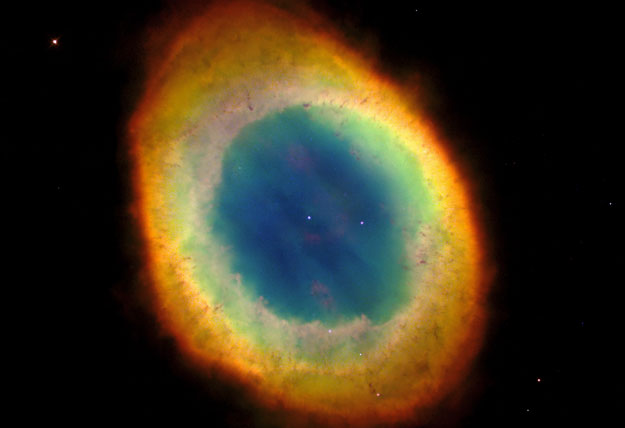
|
Explanation: Except for the rings of Saturn, The Ring Nebula (M57) is probably the most famous celestial band. This planetary nebula's simple, graceful appearance is thought to be due to perspective -- our view from planet Earth looking straight into what is actually a barrel-shaped cloud of gas shrugged off by a dying central star. Astronomers of the Hubble Heritage Project produced this strikingly sharp image from Hubble Space Telescope observations using natural appearing colors to indicate the temperature of the stellar gas shroud. Hot blue gas near the energizing central star gives way to progressively cooler green and yellow gas at greater distances with the coolest red gas along the outer boundary. Dark, elongated structures can also be seen near the nebula's edge. The Ring Nebula is about one light-year across and 2,000 light-years away in the northern constellation Lyra.
|
January February March April May June July August September October November December |
| |||||||||||||||||||||||||||||||||||||||||||||||||||||||
NASA Web Site Statements, Warnings, and Disclaimers
NASA Official: Jay Norris. Specific rights apply.
A service of: LHEA at NASA / GSFC
& Michigan Tech. U.
Based on Astronomy Picture
Of the Day
Publications with keywords: nebula - planetary nebula - Ring Nebula - ring - M 57
Publications with words: nebula - planetary nebula - Ring Nebula - ring - M 57
See also:
- The Medusa Nebula
- Jones Emberson 1
- APOD: 2024 June 11 Á Colorful Stars and Clouds near Rho Ophiuchi
- APOD: 2024 April 28 Á Rings Around the Ring Nebula
- APOD: 2024 February 12 Á HFG1 & Abell 6: Planetary Nebulae
- APOD: 2024 January 23 Á Deep Nebulas: From Seagull to California
- APOD: 2023 December 24 Á NGC 2440: Cocoon of a New White Dwarf
